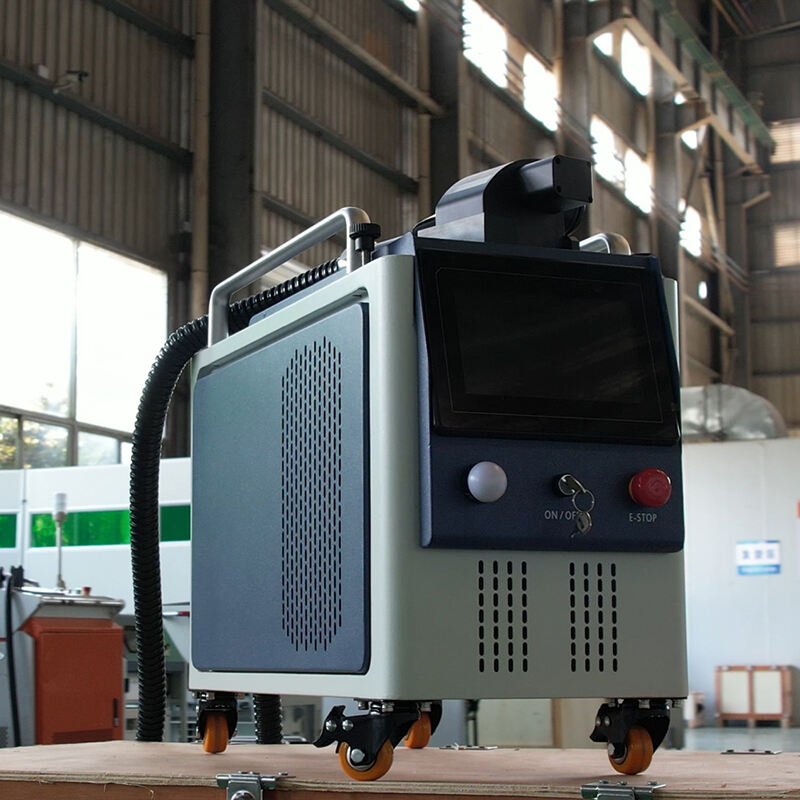Wire feed laser welding is a neat way to connect metal and it involves a special machine called a laser rust removal gun. This machine has the ability to make welding faster and more precise. Today we are going to find out about wire feed laser welding — what it is and how it work!
Wire feed laser weld is made by the laser beam, melts the metal parts into a whole. You know using some kind of insanely bright flashlight that melts two pieces of metal and makes them stick together! The machine also uses a thin wire that feeds into the laser beam to fill in the gaps between the metal pieces. This makes the weld stronger.
When to Use A Wire Feed Laser WelderThere are so many ways a Rust remover machine can be useful. One huge reason is the ability to weld extremely thin pieces of metal without warping them. So this is useful for things like electronics and jewelry where precision matters. They’re also incredibly fast workers and can help companies save time and money. And they produce less heat than other welding techniques, so the metal remains unscorched.

Wire Feed Laser Welder – Sound Difficult? It’s Not As Bad As You Think…Welding with a wire feed laser welder may seem difficult the first time you try, but it gets better with time. First, check the machine is correctly set up and the laser beam is correctly focused. You also have to feed the wire into the path of the laser beam properly and at an appropriate speed and direction in order to obtain a strong weld. It’s a good idea to practice on some scrap metal before you start with your final piece.

Numerous and people in different industries use wire feed laser welding. In the auto industry, it’s used to weld car parts together, including exhaust systems. In the airplane business, it both keeps airplane parts strong and light. And in medicine, it can pave the way for dependable medical devices. Regardless of the industry, the wire feed laser welding process always makes products better.

As with all machinery, wire feed laser welders require maintenance to perform their best. This involves the occasional cleaning, checking for and fixing anything that may be loose, and making sure all parts are in good condition. If you screw up — the laser beam doesn’t quite focus right, the wire isn’t feeding — don’t worry. Refer to the machine’s manual for assistance or consult a professional.
DMK is found inside the East Lake High-tech Development Zone in Wuhan. We are the enterprise which was high-tech specializes in studies, development and manufacturing of complete sets of laser equipment. The group that founded us is created upwards of postgraduate level holders, and we hire a staff comprised of over a dozen scientists which are technical. We have a state-of-the-art production center for laser equipment in addition to a team of after-sales specialists which can provide personalized options to clients in the domestic and market that is international. We provide professional after-sales service for any nagging issue associated to the merchandise promptly.
Currently, our company has the supply chain encompassing 8 areas that are main a range that is big of these because the production that are complete of cutting machines, laser welding machines, laser cleansing machines, and the strategy of getting elements like fiber lasers, cutting lasers, laser welding minds, laser cleansing minds, also as laser control systems. Our products are commonly used in industries such as for instance sheet {keyword} processing and protection which is environmental vessels, agricultural machinery, aerospace, and the development of new energy. The Middle East, Western Europe and Russia with the capacity to import and export items that have accumulated a share that keeps growing of marketplace in international markets, such as for instance for instance East Asia, North America, Latin America.
Due to the fact world continues to advance in wire feed laser welder technology, we've included laser which is world-class and procedures. In collaboration with top suppliers in the US of lasers and control systems, such since Raycus, MAX, JPT, Friendess, Raytools, SUP, QILIN, and ESTUN We are dedicated to provide affordable laser cutting to our customers, welding, cleaning, cladding, and marking tools. From the professional's attitude, in laser procedures, we carefully choose each element of our equipment, rigorously monitor assembly processes, and conduct rigorous inspections of the factory. With these efforts we can allow Chinese manufacturing to continue to give a better experience for global consumers.
We always adhere to the core values of "customer-centricity" and "creating customer-satisfying benefits." We place customer specifications near the top our range of priorities. Our company is individuals being active the "Made in China 2025 initiative" and use technology and services to upgrade the laser industry intelligently. Motivated due to the two forces for the Internet+ and Industry 4.0 that people are closely aligned with demands of this Internet that are industrial age. We provide the absolute many wire feed laser welder that is advanced technology and application service in the marketplace, and get together with our partners to achieve greater speeds, additional cost-effective and faster growth.